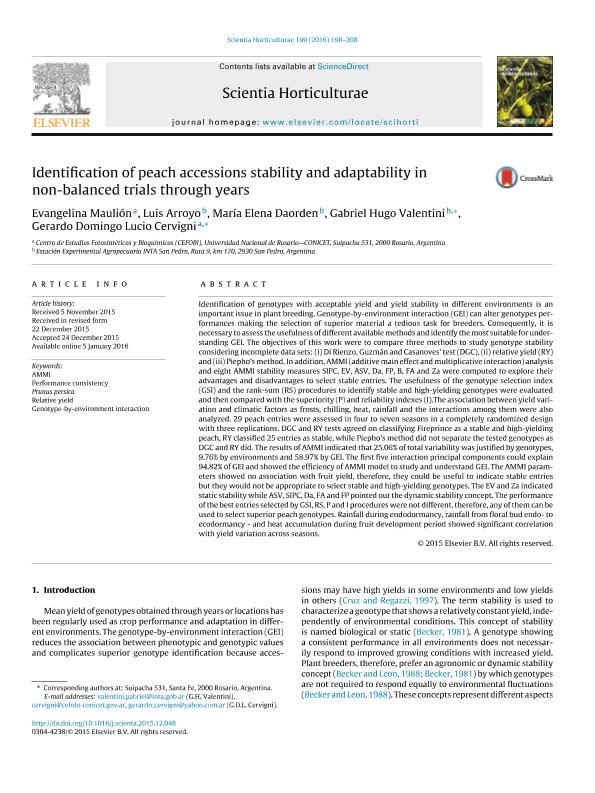Mostrar el registro sencillo del ítem
dc.contributor.author
Maulión, Evangelina

dc.contributor.author
Arroyo, Luis
dc.contributor.author
Daorden, María Elena
dc.contributor.author
Valentini, Gabriel Hugo
dc.contributor.author
Cervigni, Gerardo Domingo Lucio

dc.date.available
2018-07-17T20:04:43Z
dc.date.issued
2016-02
dc.identifier.citation
Maulión, Evangelina; Arroyo, Luis; Daorden, María Elena; Valentini, Gabriel Hugo; Cervigni, Gerardo Domingo Lucio; Identification of peach accessions stability and adaptability in non-balanced trials through years; Elsevier Science; Scientia Horticulturae; 199; 2-2016; 198-208
dc.identifier.issn
0304-4238
dc.identifier.uri
http://hdl.handle.net/11336/52516
dc.description.abstract
Identification of genotypes with acceptable yield and yield stability in different environments is an important issue in plant breeding. Genotype-by-environment interaction (GEI) can alter genotypes performances making the selection of superior material a tedious task for breeders. Consequently, it is necessary to assess the usefulness of different available methods and identify the most suitable for understanding GEI. The objectives of this work were to compare three methods to study genotype stability considering incomplete data sets: (i) Di Rienzo, Guzmán and Casanoves' test (DGC), (ii) relative yield (RY) and (iii) Piepho's method. In addition, AMMI (additive main effect and multiplicative interaction) analysis and eight AMMI stability measures SIPC, EV, ASV, Da, FP, B, FA and Za were computed to explore their advantages and disadvantages to select stable entries. The usefulness of the genotype selection index (GSI) and the rank-sum (RS) procedures to identify stable and high-yielding genotypes were evaluated and then compared with the superiority (P) and reliability indexes (I). The association between yield variation and climatic factors as frosts, chilling, heat, rainfall and the interactions among them were also analyzed. 29 peach entries were assessed in four to seven seasons in a completely randomized design with three replications. DGC and RY tests agreed on classifying Fireprince as a stable and high-yielding peach, RY classified 25 entries as stable, while Piepho's method did not separate the tested genotypes as DGC and RY did. The results of AMMI indicated that 25.06% of total variability was justified by genotypes, 9.76% by environments and 58.97% by GEI. The first five interaction principal components could explain 94.82% of GEI and showed the efficiency of AMMI model to study and understand GEI. The AMMI parameters showed no association with fruit yield, therefore, they could be useful to indicate stable entries but they would not be appropriate to select stable and high-yielding genotypes. The EV and Za indicated static stability while ASV, SIPC, Da, FA and FP pointed out the dynamic stability concept. The performance of the best entries selected by GSI, RS, P and I procedures were not different, therefore, any of them can be used to select superior peach genotypes. Rainfall during endodormancy, rainfall from floral bud endo- to ecodormancy - and heat accumulation during fruit development period showed significant correlation with yield variation across seasons.
dc.format
application/pdf
dc.language.iso
eng
dc.publisher
Elsevier Science

dc.rights
info:eu-repo/semantics/openAccess
dc.rights.uri
https://creativecommons.org/licenses/by-nc-sa/2.5/ar/
dc.subject
Ammi
dc.subject
Genotype-By-Environment Interaction
dc.subject
Performance Consistency
dc.subject
Prunus Persica
dc.subject
Relative Yield
dc.subject.classification
Otras Ciencias Biológicas

dc.subject.classification
Ciencias Biológicas

dc.subject.classification
CIENCIAS NATURALES Y EXACTAS

dc.title
Identification of peach accessions stability and adaptability in non-balanced trials through years
dc.type
info:eu-repo/semantics/article
dc.type
info:ar-repo/semantics/artículo
dc.type
info:eu-repo/semantics/publishedVersion
dc.date.updated
2018-07-17T13:58:45Z
dc.journal.volume
199
dc.journal.pagination
198-208
dc.journal.pais
Países Bajos

dc.journal.ciudad
Amsterdam
dc.description.fil
Fil: Maulión, Evangelina. Consejo Nacional de Investigaciones Científicas y Técnicas. Centro Científico Tecnológico Conicet - Rosario. Centro de Estudios Fotosintéticos y Bioquímicos. Universidad Nacional de Rosario. Facultad de Ciencias Bioquímicas y Farmacéuticas. Centro de Estudios Fotosintéticos y Bioquímicos; Argentina
dc.description.fil
Fil: Arroyo, Luis. Instituto Nacional de Tecnología Agropecuaria. Centro Regional Buenos Aires Norte. Estación Experimental Agropecuaria San Pedro; Argentina
dc.description.fil
Fil: Daorden, María Elena. Instituto Nacional de Tecnología Agropecuaria. Centro Regional Buenos Aires Norte. Estación Experimental Agropecuaria San Pedro; Argentina
dc.description.fil
Fil: Valentini, Gabriel Hugo. Instituto Nacional de Tecnología Agropecuaria. Centro Regional Buenos Aires Norte. Estación Experimental Agropecuaria San Pedro; Argentina
dc.description.fil
Fil: Cervigni, Gerardo Domingo Lucio. Consejo Nacional de Investigaciones Científicas y Técnicas. Centro Científico Tecnológico Conicet - Rosario. Centro de Estudios Fotosintéticos y Bioquímicos. Universidad Nacional de Rosario. Facultad de Ciencias Bioquímicas y Farmacéuticas. Centro de Estudios Fotosintéticos y Bioquímicos; Argentina
dc.journal.title
Scientia Horticulturae

dc.relation.alternativeid
info:eu-repo/semantics/altIdentifier/doi/https://dx.doi.org/10.1016/j.scienta.2015.12.048
dc.relation.alternativeid
info:eu-repo/semantics/altIdentifier/url/https://www.sciencedirect.com/science/article/pii/S0304423815303733
Archivos asociados
